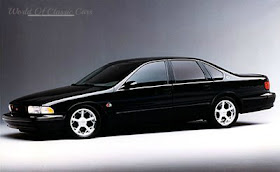marți, 26 aprilie 2016
Five Muscle Machines That Broke The Mold - World Of Classic Cars -
In the ’60s and ’70s, “muscle car” most often meant a midsize American coupe with a high-performance V-8 and rear-wheel drive, period. But as Detroit performance started making a comeback in the late 1980s, and with V-8s on the decline, carmakers began stretching that definition. Some new approaches to American muscle set the blueprint for future models, and some became instant cult classics.
Here are five that broke the muscle car mold.
1986–87 Buick Grand National
The Buick’s extraordinary big bad Grand National is forever cemented into muscle car history, but when it was new, there were those who sneered at its “small” turbocharged V-6. Muscle purists just couldn't get on board with a computerized six-banger taking the place of a hulking V-8.
The GN’s high-13/low-14-second quarter-mile times, in stock form, changed a lot of minds. And for those who preferred their muscle with stealth, Buick also offered the GN’s “plain clothes” sibling, the Regal T-Type.
Stock output of the Buick’s intercooled 3.8-liter turbo V-6 was 245 net horsepower and 355 pound-feet of torque. (By comparison, the 1986 Corvette’s V-8 made 230 horsepower and 330 pound-feet). The turbo Buicks crushed the preconception that “computer cars” could not be tuned for even higher performance. It turns out, that was pretty easy.
Buick ended the Grand National’s run with the 1987 GNX, a pinnacle muscle machine with a McLaren/ASC-tuned turbo V-6 making 300 horsepower and a stonking 420 pound-feet of torque. Buick made just 547 GNXs, and one with 362 original miles sold for $165,000 at Barrett-Jackson’s 2015 Palm Beach auction.
1988–92 Lincoln Mk VII LSC
The “hot rod Lincoln” was in many ways a muscle car for the country club set. The sleek design blended Euro sophistication with pure American swagger.
Lincoln boldly pitched the Mk VII as a competitor to the Mercedes-Benz 560 SEC coupe, which cost nearly three times the Mk VII LSC’s $27,000 price. Starting in mid-1987, when it gained the Mustang’s 5.0-liter H.O. V-8 with 225 horses and 300 pound-feet of torque, the Mk VII LSC (for Luxury Sports Coupe) essentially matched the big Benz’s power (238 hp, 287 lb-ft).
The Mk VII LSC’s mid-15-second quarter-mile times were right there with Trans-Ams and IROC Camaros of the day, along with numerous classic muscle cars. Based on the Thunderbird platform — itself a version of the Ford Fairmont’s Fox chassis — the Mk VII rode on a longer, 108-inch wheelbase. It was a roomy midsize coupe and pretty close in concept to classic muscle cars in that regard. Air suspension made the Mk VII a cushy yet agile cruiser. Too bad Lincoln has nothing like it today.
1989–91 Ford Taurus SHO
The Ford Taurus SHO stretches the definition of “muscle car,” but a speedy four-door held strong appeal for gearheads who needed a family hauler. The $20,000 price was reasonable, too. SHO stood for “Super High Output,” from a Yamaha-built version of Ford’s 3.0-liter Vulcan V-6. The high-winding V-6 made 220 horsepower and 200 pound-feet of torque, and the SHO came only with a five-speed stick until 1992.
The aluminum SHO V-6 used the day’s best engine tech: double overhead camshafts, four valves per cylinder and a variable intake manifold, with the coolest looking set of intake runners outside of an Italian exotic. While front-wheel drive might seem to disqualify the SHO as a muscle car, the SHO was just a few ticks off a 5.0-liter Mustang’s quarter-mile time, according to Car and Driver. From there, the Taurus SHO pulled away from the Mustang to a 143-mph top speed, making it the fastest sedan available for under $60,000.
1992–93 GMC Typhoon
After building the shocker of the year with the 1991 Syclone pickup, GMC put the freakishly fast pickup’s mechanical package into the more versatile Jimmy sport-utility to create the 1992 Typhoon. With the same 280-horsepower turbocharged 4.3-liter V-6 and full-time all-wheel-drive system as the Syclone, the Typhoon offered about the same performance, including 14-second quarter-mile times. But it had room for five and their luggage, which broadened its market.
Handling was good but not great. Remember, this thing still had a pickup truck frame and solid rear axle on leaf springs. The $30,000 price was an obstacle, but GMC still built about 4,700 Typhoons. The Typhoon was well ahead of its time; a quarter-century later, the hot models from luxury brands are hot rod SUVs.
1994–96 Chevrolet Impala SS
By the early 1990s, GM’s big rear-drive coupes were history. So Chevy did something crazy by building a four-door muscle car. The 1994–96 Impala SS followed in the tire tracks of the 1960s Impala SS models, but it was even quicker.
The 1994–96 Impala SS was essentially a Caprice with most of the 9C1 police package chassis hardware, plus 17-inch aluminum wheels, black paint and trim and a leather-swathed cabin. Other colors were offered later. The LT1 5.7-liter small-block’s 260 horsepower and 330 pound-feet of torque could hurl the big boat down the quarter-mile in 15 seconds flat, according to Car and Driver. (As a comparison, Car Life magazine had clocked a 1967 Impala SS427 at 15.7 seconds.) The 1994–96 Impala SS was also a surprisingly good back road handler, far better than its ancestors and comparable to some European sport sedans.
Chevy made just over 70,000 of the big muscle machines before putting its old rear-driver out to pasture after 1996. The Impala SS left a lasting impact, however, opening the doors, so to speak, for future muscle four-doors, including today’s Chevrolet SS and the Dodge Charger R/T.







Niciun comentariu:
Trimiteți un comentariu